本帖最后由 seven_nana 于 2023-2-26 22:54 编辑
日德兰纪念系列 - 战略战术篇 - 第四章 - 后续影响
本帖内容未经允许不得转载
主要参考资料:
From the Dreadnought to Scapa Flow, Volume III, Jutland and After, May to December 1916, 作者Arthur J. Marder
From the Dreadnought to Scapa Flow, Volume IV, 1917, Year of Crisis, 作者Arthur J. Marder
The Rules of the Game: Jutland and British Naval Command,作者Andrew Gordon
对于英国海军来说,日德兰海战的结果是令人失望的,因此在战斗结束后不久,他们便着手寻找原因,并试图予以改进。在本次海战结束至整场战争结束的2年多时间内,他们在技术层面做出了许多的改进,在战略和战术层面上也做出了一些调整。然而,这些调整最终并未派上用场,因为自1917年起,潜艇战成为了海上对抗的主角,而规模庞大的主力舰队,则陷入了近乎于无所事事的境地。作为战略战术篇的收尾章节,我们将对这些话题,做出具体的解读。
一、战略层面的影响
1. 根据英国海军官方资料,日德兰海战对战略层面的影响如下:
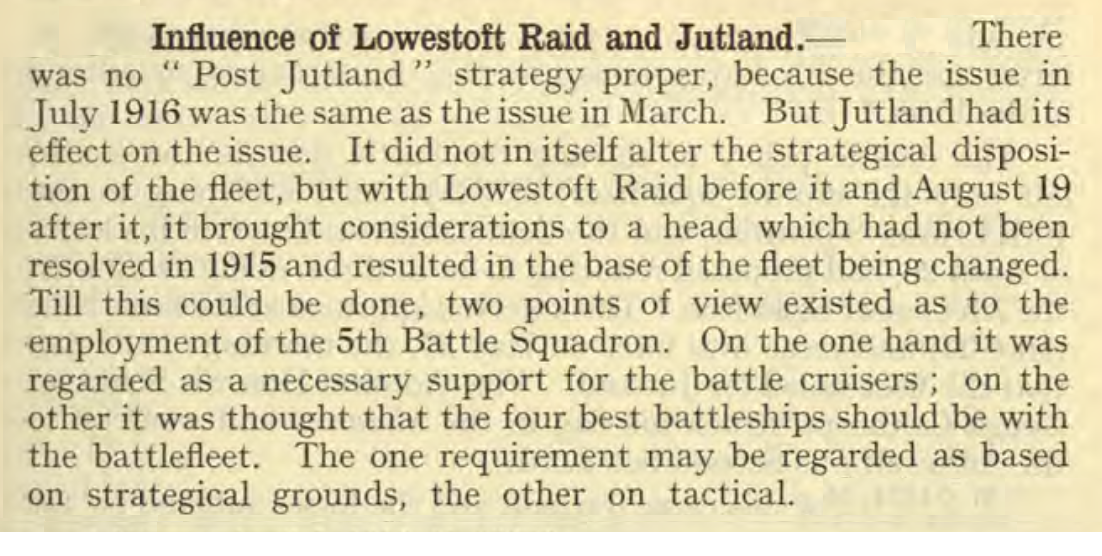
“后日德兰时代的海军战略”这个概念,是不存在的。因为1916年7月时的局面,与3月时的局面并无区别。但这也不是说,日德兰海战并未对战略产生任何影响——单凭这场海战,的确没有产生影响,但在结合了1916年4月25日的洛斯托夫特袭击(可以认为是日德兰海战的前序,但德国舰队仅与哈里奇分舰队发生了接触,因此整体交战规模较小)、以及1916年8月19日的海上冲突(可以认为是日德兰海战的后续,双方的潜艇都对敌方造成了一定杀伤,但双方的水面舰艇部队并未发生实质性的接触,因此整体交战规模较小)之后,这三场海战共同产生了战略上的影响,那就是将大舰队的基地南迁至福斯湾(南迁之后,能对德国海军的水面袭击行动做出更快的反应)。
由于基地南迁所需的工作量极大,因此在这项工作完成之前,有一个更为紧迫的事项需要解决,那就是第5战列舰中队究竟应该如何部署:有人认为,这支部队应该用作战列巡洋舰队的支援力量,也有人认为,这支部队应该伴随战列舰队行动。这两种观点,一种偏重战略层面的考量,另一种则偏重战术层面的考量。
2. 第5战列舰中队的角色与归属,可以说是日德兰海战之后,英国海军在战略层面上的最大争议。根据Arthur J. Marder的说法(From the Dreadnought to Scapa Flow, Volume III, Jutland and After, May to December 1916, P.227-228 & P.230-231):
In mid-June the C.-in-C. declared that Jutland established two important points as regards Grand Fleet dispositions: '(a) Our lightly armoured B.C.s are not a match, ship for ship, for the Germans. The result is they must not be too far from the Battle Fleet. (b) Our 5th B.S. is not fast enough to get away from the German 3rd B.S. and cannot therefore be used as a backing up force for the B.C.F., far from the main Fleet.'
在1916年6月中旬时,大舰队总司令杰里科宣称,从大舰队的部署的角度说,日德兰海战的重要战训是:(a) 英国战列巡洋舰的装甲防护有所不足,在单舰对抗的层面上,无法与德国战列巡洋舰相匹敌。因此,这些军舰不应过于远离战列舰队。(b) 英国第5战列舰中队的航速,并没有比德国第3战列舰中队快太多,并不足以使前者逃脱后者的追击,因此不适合在远离战列舰队的地方,用作战列巡洋舰队的支援力量。
The Admiralty conference of 25 June laid down that the 5th Battle Squadron was to be regarded 'mainly as a fast wing division of the battle fleet and not as a portion of the Battle Cruiser Fleet'...Beatty worked hard for a reversal or modification of this decision. In the end, with unintentional assistance from the Germans, Beatty was able to secure a modification. After the enemy sortie of 19 August, the 5th Battle Squadron was stationed with the Battle Cruiser Fleet at Rosyth. The C.-in-C. controlled its tactical disposition, however, and he imposed the condition that the Battle Cruiser Fleet and the 5th Battle Squadron should thereafter keep in visual contact with him.
在1916年6月25日的海军部会议上,英国海军高层做出的决定是,整体来说,第5战列舰中队应当用作战列舰队的快速分队,而不是作为战列巡洋舰队的一部分。针对这个情况,贝蒂花了很大功夫,试图扭转这个决定,但最后,是德国人无意间帮了他一个忙:在1916年8月19日的海上冲突(德国海军的又一次袭击英国沿岸地区的企图,此战中,双方潜艇都雷击了对方的军舰,但双方主力舰队并未发生实际接触)之后,海军部决定,第5战列舰中队应与战列巡洋舰队一起,部署在福斯湾。但在战术上,第5战列舰中队则需听命于大舰队总司令,且后者还强调,战列巡洋舰队和第5战列舰中队,以后不能脱离大舰队单独行动,而是要与其保持在视线接触范围内。
3. 至于基地南迁这件事,则花了1年多时间才完成。根据Andrew Gordon的说法(The Rules of the Game: Jutland and British Naval Command, P.25 & P.507 & P.533):
A fleet based in the far north could not hope to intercept or deter hit-and-run raids on English coastal towns by German battlecruisers...The two parts of the fleet must be united at a common base, and that that base could only be the Firth of Forth. This decision would take well over a year to implement, for the space necessary to protect the entire fleet from U-boats required storm-proof boom defences to be stretched across the outer part of the Firth, and that meant a huge commitment of buoyage, nets, ground-tackle and defensive minefields...the fleet moved south to Rosyth, in April 1918.
当德国战列巡洋舰对英国沿海城镇发起打了就跑式的袭击时,一支部署在英国最北端的舰队(指部署在斯卡帕湾的大舰队),是无法对其做出有效的阻吓或拦截的。因此,战列舰队和战列巡洋舰队,必须部署在同一个基地,而具体的选址必然是福斯湾(而非斯卡帕湾)。在做出基地南迁的决定后,英国人花了一年多的时间来做准备工作:他们需要将反潜栅栏的布置范围扩大到福斯湾的最外围,从而将安全水域的面积,扩大到能容纳整个大舰队的程度;除此之外,还需要设置大量的浮标、绳网、锚泊装置、以及防御性雷区。在此情况下,直到1918年4月时,大舰队才南迁至罗塞斯(即福斯湾)。
结论:日德兰海战本身,并未对英国海军的战略造成多大的影响,但在结合了之前及之后的战事后,引发了大舰队驻地的南迁。
二、战术层面的改变
1. 根据英国海军官方资料,在日德兰海战后,战术层面的改变如下:
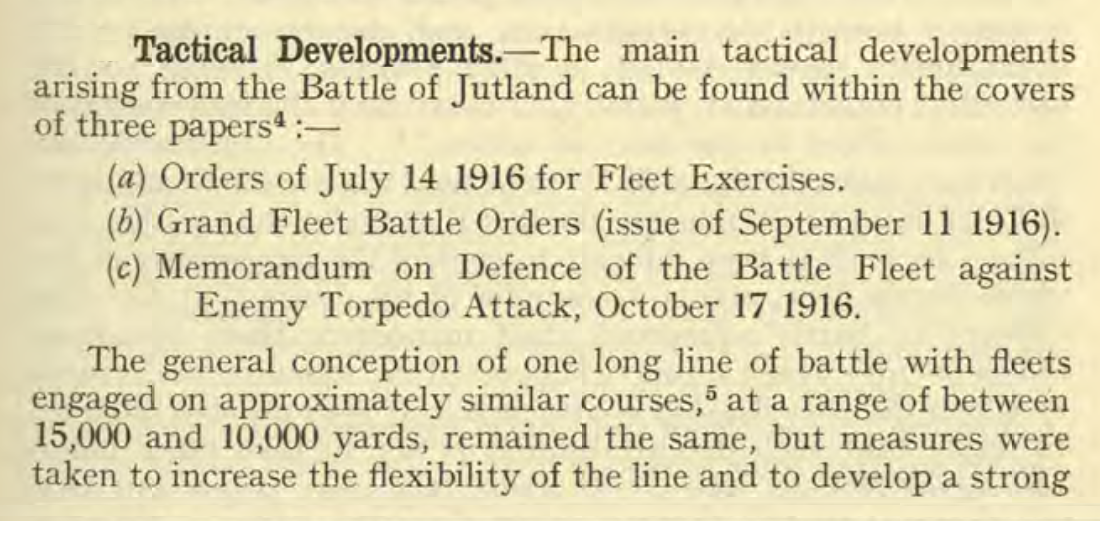
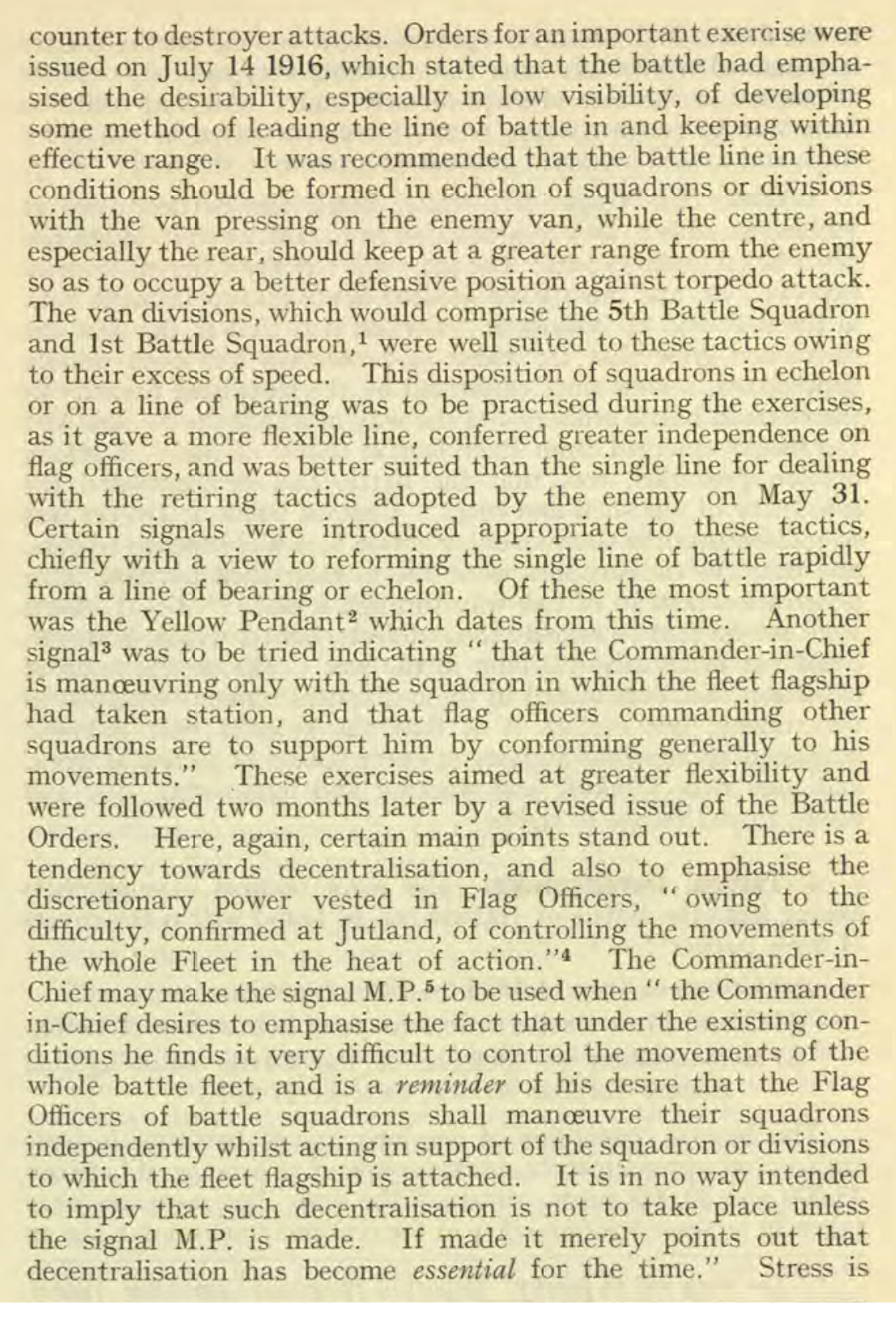
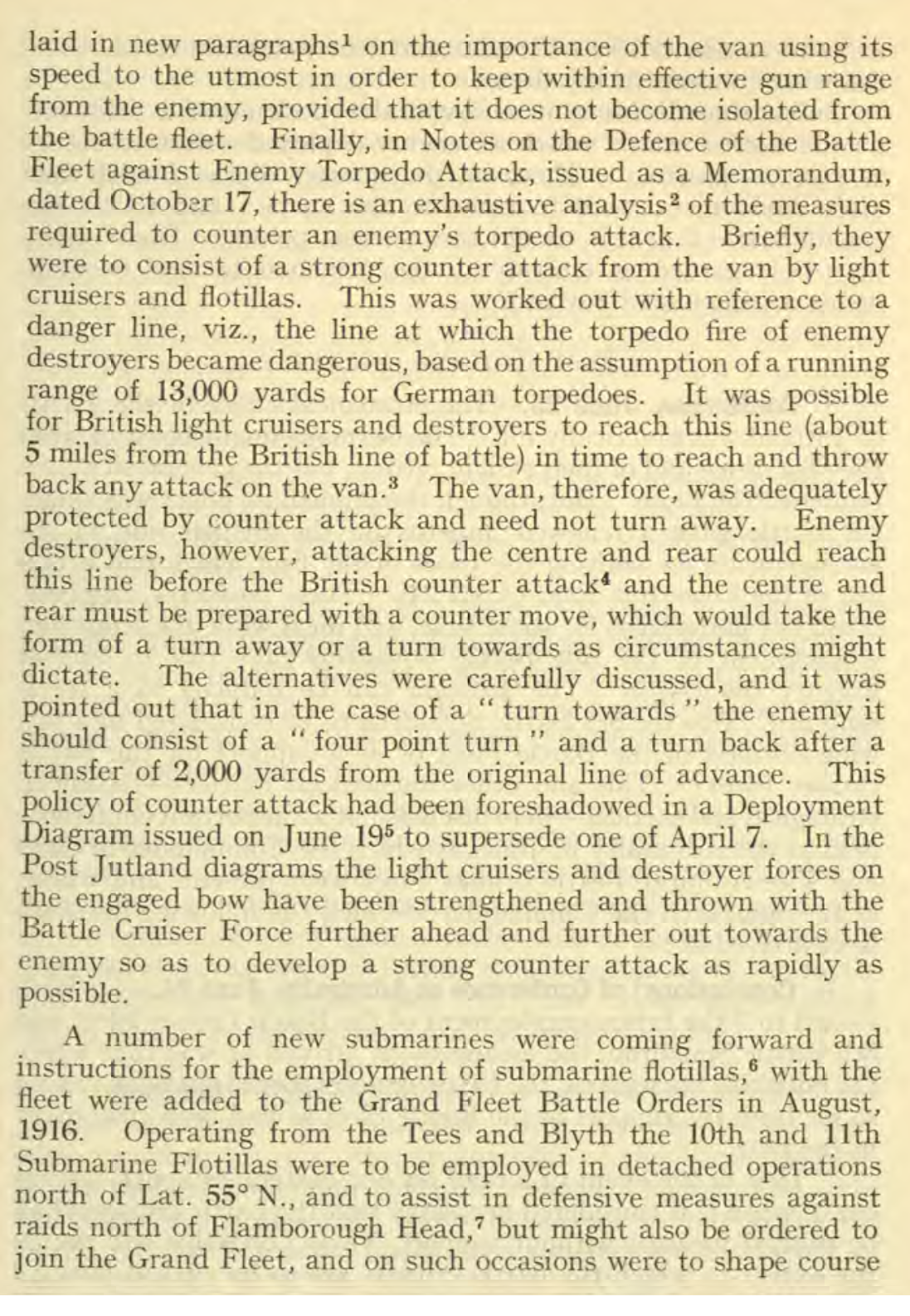
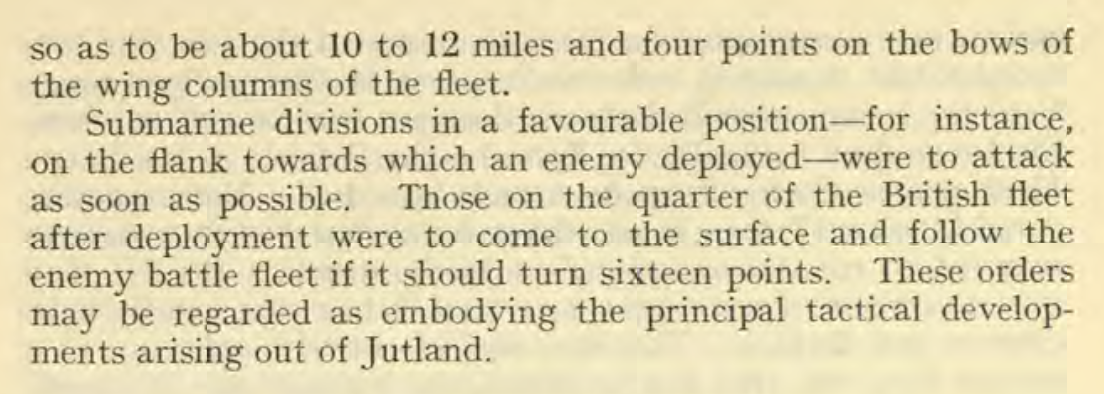
日德兰海战后的战术变化,主要被记录在以下三份文件中:
(a) 1916年7月14日的舰队演习命令
(b) 1916年9月11日下发的【大舰队战斗命令】
(c) 1916年10月17日的战列舰队抵御敌方雷击的备忘录
整体的战术思想,还是与此前保持一致,既两支舰队会排成长长的战列线,在大致相同的航向下,于10,000-15,000码距离上交战。但在日德兰海战之后,英国海军更加重视战列线的灵活性问题,以及反制敌方驱逐舰队雷击的能力。
1916年7月14日时下发的舰队演习命令中表示,日德兰海战的经验表明,低能见度环境下的舰队指挥能力,有必要得到加强,从而避免在这类环境下被敌方舰队甩掉。具体的建议是,在这种环境下,整条战列线可以中队或分队为单位,调整为斜队。其中,我方的前卫将会对敌方的前卫保持施压,而我方战列线的中央和后卫,尤其是后卫,将会与敌方保持较远的距离,从而在敌方发起雷击时,能处在更有利于防御的位置上。由于前卫部队,具体来说就是第5战列舰中队和第1战列舰中队,在航速方面具备一定的优势,因此很适合执行这样的战术。而与纵队相比,斜队则具备更好的灵活性,各中队或分队的指挥官则会具备更高的自主权,因此更适合用来对抗德国海军在日德兰海战中所采用的退却战术。在那次演习中,我们练习了这种战术。
在这场演习的2个月之后,又下发了修订版的【大舰队战斗命令】。在此修订版中,出现了去中心化的趋势,并且也更为强调中队/分队指挥官们的自主权。此外,还强调了前卫部队应充分利用其速度优势,在不与本方主力脱节的前提下,将敌我双方距离保持在火炮有效射程内。
最后,1916年10月17日的战列舰队抵御敌方雷击的备忘录,就抵挡敌方雷击行动的话题,展开了长篇分析。简单来说,反制手段主要是由位于舰队前方的轻巡洋舰和驱逐舰来展开反击。只要我方轻型舰艇能及时做出反击,并赶走敌方雷击舰艇,那么我方的前卫战列舰就无需做出规避机动。然而,我方轻型舰艇无法及时阻止敌方对我方战列线中央及后卫发起的雷击,因此中央和后卫战列舰需要做好进行规避机动的准备,规避方式可能是驶离敌方,也可能是驶向敌方,具体需结合实际情况来决定。与这种战术相对应的,是日德兰海战后下发的阵型图——相比于4月7日时下发的阵型图,6月19日下发的阵型图,加强了舰队前方的轻巡洋舰和驱逐舰力量,且其阵位距离战列巡洋舰更远、更靠近敌方舰队,因此能更为快速地发起反击。
另外,由于大舰队编制中新增了潜艇部队,因此自1916年8月起,【大舰队战斗命令】中还增加了有关潜艇部队的内容。新编入的第10和第11潜艇中队,除了单独行动或参与防御性任务外,还可能会与大舰队共同行动。在后一种情况下,潜艇部队的阵位,将位于舰队前方10-12海里、斜前方4个罗经点的方位上。处在有利位置的潜艇部队,例如靠近敌方战列线展开位置的潜艇部队,应在条件允许的情况下尽快发起攻击。如果在我方战列线展开后,潜艇部队处于战列线的后方位置,则应上浮到水面,并在敌方舰队撤退时展开追击。以上这些内容,可以认为是日德兰海战后的战术思想变化的具体体现。
2. 除了上述内容之外,在驱逐舰队的运用、以及夜战战术方面,英国海军也做出了调整。根据Arthur J. Marder的说法(From the Dreadnought to Scapa Flow, Volume III, Jutland and After, May to December 1916, P.225-226):
A revision in the G.F.B.O.s on 21 November carried offensive destroyer tactics an important step further, once and for all scrapping the predominantly defensive function assigned to the flotillas at Jutland, at the same time promising to make it more difficult for an enemy fleet to break off action.
1916年11月21日时,【大舰队战斗命令】再度得到了修订。在这个版本中,驱逐舰的进攻职能被进一步强调,并背离了日德兰海战时采用的强调驱逐舰的防御职能的做法。加强驱逐舰的进攻职能的一个好处是,敌方战列舰队在试图撤退的时候,不会像之前那样容易了。
A tactical error committed in the night action at Jutland was the failure to detail a force to locate and maintain touch with the enemy battle fleet. A revision of the G.F.B.O.s of 26 October, dealing with night actions, laid down that: 'One or more light-cruiser squadrons will be detailed to locate the enemy after dark if touch has been lost, and they will be accompanied by destroyer flotillas, which are to attack when the light-cruisers have gained touch with the enemy (this force will be known as the Attacking force). If any light-cruiser squadrons are in touch with the enemy at dark they will be joined by the flotillas detailed for the attack.'
在日德兰海战的夜战阶段中,英国海军没有派出部队去主动寻找敌方舰队,并与之保持接触。这显然是一个战术上的失误。在10月26日的修订版的【大舰队战斗命令】中,对夜战规则进行了如下调整:“入夜之后,如果我们与敌方舰队未能保持目视接触,那么我们会派出至少一个轻巡洋舰中队,去寻找敌方舰队。这些轻巡洋舰将得到驱逐舰中队的陪伴,后者会在轻巡洋舰发现敌方舰队后,对敌方发起攻击(这支部队被称为攻击部队)。当一支轻巡洋舰部队与敌方产生接触后,其余的轻型舰艇部队会加入到夜间攻击行动中”。
Although these revised orders provided for a definite attacking force at night after an action, there was no serious attempt until after the war to develop night fighting between battle fleets, despite significant improvements in 1917 in the control of searchlights and the introduction of star shell. It was still held that it would always be something of a gamble, and that it would afford opportunities for the weaker fleet that would never occur in daylight and high visibility.
尽管上述的修订,订立了具体的夜战攻击方式,但这仅限于轻型舰艇部队——尽管在1917年时,英国海军的探照灯控制技术已经得到了大幅改善,并且还引入了照明弹,但在大战期间,他们始终不打算让战列舰队参与夜战——他们还是认为,主力舰参与夜战是一种赌博行为,有可能让弱势一方的舰队,获得在日间战斗或高能见度战斗中不可能获得的克敌机会。
3. 后来,当杰里科升任第一海务大臣后,贝蒂接替他成为了大舰队总司令。有学者认为,贝蒂在战术方面并未做出大幅度的调整。根据Arthur J. Marder的说法(From the Dreadnought to Scapa Flow, Volume IV, 1917, Year of Crisis, P.31 & P.34):
Beatty's lament after Jutland, 'There is something wrong with our system,' did not lead to a revolution in tactics when he became C.-in-C.; he saw no need to go far beyond the post-Jutland modifications in the G.F.B.O.s. On the three main points which had given rise to so much discussion after the battle - decentralization of command v. centralization, divided tactics v. concentration of the battle fleet, and a fleet turn towards v. away from a massed torpedo attack - Beatty came down on the side of greater decentralization, maintenance of concentration, and more aggressive anti-torpedo tactics, all with qualifications, however.
尽管在日德兰海战后,贝蒂曾抱怨道:“我们的指挥体系有问题”,但当他成为大舰队总司令后,却并未在战术领域进行革命。在他看来,没有必要对后日德兰时期的【大舰队战斗命令】做出大幅度的改动。至于日德兰海战后得到广泛讨论的三大战术话题:去中心化指挥与中心化指挥、分队战术与战列线战术、以及如何应对敌方的大规模雷击,贝蒂更偏向于去中心化、战列线战术、以及更为激进的反雷击战术,但这些都是有相应的限定条件的。
Like the G.F.B.O.s of 1914-1916, Beatty's stressed the long-range gunnery duel on parallel courses as 'the form of action likely to give the most decisive results'; but they stated the doctrine of the tactical offensive more clearly and forcibly.
整体来说,贝蒂与杰里科一样,都认为两支舰队在平行航线下开展远距离炮战,是最有可能取得决定性战果的交战方式。但与杰里科不同的是,贝蒂的战术思想更强调进攻精神。
4. 但也有学者认为,贝蒂在战术方面进行了革新。根据Andrew Gordon的说法(The Rules of the Game: Jutland and British Naval Command, P.526-529):
Beatty and his followers brought a sense of a new dawning to the fleet’s higher strata. While he himself cannot be ranked among the most prominent military brains of the twentieth century, he grasped fundamentals of naval warfare which had not been taken on board by some of his technically more proficient, or career-serving, seniors and contemporaries. At any rate, he made use of - certainly gave rein to - a number of officers, such as Reginald Plunkett, Osmond Brock and Herbert Richmond, who can be counted among the Royal Navy’s emerging doctrinal thinkers.
贝蒂和他的亲信们,在进入大舰队的领导层后,带来了一股新风。尽管贝蒂本人并不能跨入20世纪最聪明的军事家们的行列,但贝蒂对海战原则的理解是很清晰的。相比之下,他的很多将官同僚们,虽然在技术领域更为专精、或者更懂得为官之道,但对海战原则的理解却不如他。并且,贝蒂手下还聚集着一批优秀的军官,例如雷金纳德·普伦基特(贝蒂手下的参谋)、奥斯蒙·布洛克(贝蒂担任大舰队总司令时的大舰队参谋长)、赫伯特·里奇蒙德(威廉·梅上将担任本土舰队司令时的旗舰舰长)等,这些人都可以说是皇家海军中最有思想的人才。
In pushing for fastest progress towards devolution, Beatty had to operate with the personnel to hand, and reform at the right speed for Herbert Richmond would have been too fast for many others in the Grand Fleet - and in some ways too fast for the C-in-C himself. For example, to the disappointment of some of his advisers, he continued to support the traditional single-line ahead “until the enemy’s fleet has been disorganized and broken up”.
为了尽快实现去中心化的指挥方式,贝蒂需要让手下的将领们都学着接受这套方式,但转变必然是需要花一些时间的,因此不能操之过急。如果按赫伯特·里奇蒙德(分队战术的强烈推崇者)的速度进行改革的话,那么大舰队中的很多军官都会觉得接受不了,甚至贝蒂自己可能也会感到跟不上节奏。举例来说,除非敌方战列线的队形已经被打乱,否则贝蒂还是支持传统的单列纵队的战列线战术的。
Beatty started by sending his admirals out from Scapa to get used to manoeuvring their squadrons without supervision; and then, in March 1917, he effectively transfused his BCFOs into the wider Grand Fleet by overriding GFBOs with two “commendably brief” pages of Grand Fleet Battle Instructions (GFBIs), setting out the principles of decentralization and anticipation which would henceforth govern the conduct of the fleet...Finally, on January the 1st, 1918, Beatty abolished GFBOs - or, rather, divided their contents into two separate volumes: an expanded version of his new GFBIs; and Grand Fleet Manoeuvring Orders (GFMOs). In the latter were consigned all those practical minutiae, collated by Jellicoe, about the handling of squadrons and flotillas, in various conditions and formations. In the former were “the guiding principles which are to be observed by all arms of the fleet when obtaining contact, and when in action, with the enemy”.
所以刚开始的时候,贝蒂只是要求他手下的将官们,率领各自的中队,独自出海进行演习(独自行动意味着没有上级命令,因此需要指挥官们自己做出决策)。接下来,在1917年3月时,贝蒂把他的【战列巡洋舰队战斗命令】,融入了【大舰队战斗命令】。其具体做法,是在后者的篇幅中加入了两页起概述作用的【大舰队战斗指示】,其中强调了去中心化的原则,并描述了舰队交战中可能会采用的指挥模式。最后,至1918年1月1日时,贝蒂最终将【大舰队战斗命令】一分为二,改成了【大舰队战斗指示】和【大舰队机动命令】。新的【大舰队战斗指示】,是基于原先的【大舰队战斗指示】扩展而来的,是在接敌以及战斗环境下的指导原则;而【大舰队机动命令】中的内容,则是自杰里科时期积累下来的,对非战斗环境下的巡航队形和操舰要求做出了详尽的规定。
Steadily, therefore, Beatty made clear that, whereas Jellicoe had expected a battle to conform to the script in GFBOs, he, for his part, expected his flag-officers to respond to the ebb and flow of the action.
通过这些调整,贝蒂逐步表明了他与杰里科在战术思想上的区别:杰里科期望战斗情形能按照【大舰队战斗命令】中设想的那般展开,而贝蒂则期望他麾下的将官们能够在战场环境下随机应变。
The successive modifications to the orders/instructions themselves, the change in their role implicit in the new nomenclature, and the innovations in the training and practices of the Grand Fleet, which took place between Jellicoe’s post-Jutland amendments and (say) the beginning of 1918, can justly be rated a cumulative revolution.
贝蒂将【大舰队战斗命令】改为【大舰队战斗指示】,不仅仅只是改变名称,也意味着这份文件的作用发生了改变(命令是必须严格执行的,而指示是指导性质的)。同时,这些命令/指示中的具体内容,也在贝蒂治下发生了变化。再加上贝蒂在大舰队的训练方式上所做出的改变,我们可以说,自1916年底至1918年初,贝蒂开展了一场渐进式的战术革命。
结论:在日德兰海战后,大舰队的战术得到了小幅但持续的改进,尤其是在贝蒂接替杰里科担任总司令后,变得更为去中心化、更强调指挥官的自主决策了。
三、舰队决战的谢幕,与无限制潜艇战的重启
1. 在日德兰海战至大战结束之间,大舰队与公海舰队仅有过一次大规模交战的机会,但由于双方都表现得过于谨慎,因此最终未能发生实质性交锋。根据Andrew Gordon的说法(The Rules of the Game: Jutland and British Naval Command, P.514-516):
The German fleet venture beyond the defensive minefields of the Heligoland Bight on three occasions after Jutland: twice in 1916 and once in 1918. The most adventurous of these forays, and the only one which raised the near-possibility of another fleet action, was the first, which took place on the 18th/19th of August. With his battleship complement (although not his battlecruiser force) restored to strength after repairs, Scheer set in motion the original bombardment plan which had been scheduled for the 31st of May...The agenda was that Hipper, with his two serviceable battlecruisers Moltke and Von der Tann, augmented by three of the most modern battleships, would bombard Sunderland and then attempt to draw Beatty into the embrace of the High Seas Fleet. The German C-in-C was satisfied that this time his “elaborate reconnaissance arrangements”, with Zeppelin scouts and U-boat tripwires, would prevent his being surprised by the Grand Fleet and having the scheme backfire on him.
在日德兰海战之后,德国舰队曾三度驶离赫尔格兰湾的防御性雷区,其中有2次是在1916年,还有一次在1918年。1916年8月18-19日的那次出击,是其中最早的、最为大胆的,并且也是仅有的一次非常接近舰队决战的机会。当时,德国海军的战列舰已经修理完毕,恢复了战斗力,但战列巡洋舰则尚未全部修理完毕(具体来说,是德尔弗林格号和塞德里茨号尚未完成修理),因此在希佩尔的侦察舰队中,除了仅有的2艘战列巡洋舰(冯·德·坦恩号和毛奇号)外,还带上了3艘最新锐的战列舰(巴伐利亚号、皇太子号、边境伯爵号),其余战列舰则都在本队中。舍尔的打算,是按照5月31日那次的原计划,对桑德兰进行炮击,从而将贝蒂引诱进公海舰队的埋伏中。区别在于,这次他安排了由齐柏林飞艇和潜艇组成的完善的侦察幕,他相信,通过这些手段,能避免让自己突然遭遇到大舰队。
As usual, Room 40 alerted the Admiralty to an impending operation, and the Grand Fleet was at sea well before the Germans...At around dawn on the 19th, the British submarine E-23 torpedoed the battleship Westfalen, which Scheer sent home under escort, while, some two hundred miles to the north, U-52 torpedoed Nottingham, which sank. The loss of one of light-cruiser was not a major factor in the half-blindfold chess game between the opposing fleets, but Jellicoe’s reaction to it was, and calls into question his mental robustness. He feared that Nottingham had been mined, and that the Grand Fleet was heading into a minefield-trap; and so he reversed the course of the entire Grand Fleet for two hours, until the situation clarified sufficiently for him to feel able to resume his southerly direction. Various excuses have been made for him; but the fact remains that four hours were lost, and that he could have frustrated any minetrap (or U-boat ambush) by sidestepping the Battle Fleet to the east, without necessarily compromising his future position vis-à-vis the High Seas Fleet.
与以往一样,40号房间破译了德国人的无线电通讯,并向情报传递给了海军部。于是,大舰队再一次赶在德国人之前出海了。在8月19日黎明时分,英国海军的E-23号潜艇发射的鱼雷,击中了德国海军的威斯特法伦号战列舰,后者在驱逐舰的护卫下返航了。而在往北大约200海里处,德国海军的U-52号潜艇,用鱼雷击沉了英国海军的诺丁汉号轻巡洋舰。在这种规模的出击行动中,损失1艘轻巡洋舰,当然不是什么大事,但杰里科对此做出的反应,却有些大惊小怪了,并且还让人怀疑起了他的意志是否足够坚强——杰里科担心,诺丁汉号是触雷沉没的,他进而担心大舰队可能正在驶向德国人布下的雷区——在此情况下,杰里科下令,整个大舰队调转航向。直到2小时后,杰里科才重新将航向调转向南方。后来,有不少人试图为杰里科开脱,但无论如何,他的确浪费了整整4个小时的时间(2小时+2小时的往返),并且他如果想避开雷区或潜艇伏击圈的话,也可以选择让大舰队往东航行,这样就不会延误战机了。
Nevertheless, there was still a good prospect of the fleets meeting, and by 2.0 p.m. the Grand Fleet was at action-stations. Another hour would have secured Jellicoe’s position astride the High Seas Fleet’s line of retreat; but fate intervened again. The Harwich destroyers were sighted by a Zeppelin which mistook some of them for battleships, and so reported them to Scheer. Presented with the apparent opportunity to defeat an isolated battle-squadron, Scheer abandoned the plan to bombard Sunderland, and turned his fleet south towards Tyrwhitt.
尽管出现了这样的插曲,但如果没有后来发生的变数的话,两支舰队还是有大概率能相遇的。至下午2点时,大舰队进入了战斗状态,只需再过1个小时,英国人就能截断公海舰队的退路了。然而,命运之手再次做出了干预——有1艘齐柏林飞艇,发现了哈里奇分舰队的驱逐舰的踪迹,并且误将其识别为战列舰,于是将这个情况汇报给了舍尔。舍尔误以为,他获得了一次能够抓住落单的英国战列舰中队的天赐良机,于是他下令放弃炮击桑德兰的计划,并率领舰队转向南方,驶向了蒂里特准将(哈里奇分舰队司令)的方向。
At 2.35 the German C-in-C suddenly abandoned this new project and turned for home. His reasons, about which he was later evasive, were surely not unconnected with the startling news, received from U-53, that Jellicoe’s massive force was only sixty-five miles to the north, steaming south. “Once again the Grand Fleet returned to harbour in a state of bitter disappointment” - losing Falmouth to another U-boat on the way.
至下午2时35分时,舍尔突然下令,放弃追击计划,转而掉头返航。他在事后给出的理由有些闪烁其词,但想必与U-53号潜艇发送给他的情报有关:根据后者的报告,杰里科的大部队,就在北方65海里处,并且正在向南航行。在德国舰队返航后,大舰队自然也就失去了交战的机会,于是再一次带着苦涩的失望返航了。并且在返航过程中,还因为U-66号潜艇的伏击,损失了法尔茅斯号轻巡洋舰。
2. 自1916年秋天开始,舰队作战又逐渐让位于潜艇战了,至1917年2月时,德国海军又恢复了无限制潜艇战。根据Arthur J. Marder的说法(From the Dreadnought to Scapa Flow, Volume III, Jutland and After, May to December 1916, P.245-247 & P.254-256; From the Dreadnought to Scapa Flow, Volume IV, 1917, Year of Crisis, P.49-51):
And so the day had ended without anything happening...It was the last time the German Fleet pushed so far into the North Sea. Although Scheer saw interesting possibilities in further sorties with a perfected reconnaissance machinery of submarines together with airships, 19 August strengthened the opinion of the Naval Staff that, while such bold sorties might damage the British Fleet, they would not produce an important, let alone a decisive, result. After 19 August 1916, therefore, the doings of the High Seas Fleet begin to fade out, and the activities of the U-boats, divorced from the fleet, become more pronounced.
8月19日的这次作战行动,就这样草草收场了,这也是德国舰队最后一次深入北海腹地的出击行动。尽管在舍尔看来,在进一步完善飞艇和潜艇的侦察机制后,公海舰队还可以继续出击,但海军总参谋部却认为,尽管这类大胆出击,有可能对英国舰队造成一定伤害,但却不可能产生重要的影响,至于打出决定性的战果,那就更加不可能了。因此,在8月19日之后,公海舰队的行动就越来越少了,而潜艇则不再与舰队绑定在一起,于是潜艇战又再次活跃起来了。
The conduct of U-boat operations was a much disputed question throughout the war, leading to serious differences within the German Government and between the Government and the Army and Navy High Commands...The worsening economic situation of the Central Powers in 1916, the result of the continuing British blockade and of such internal factors as the inability of German agriculture to expand its food output, made an early victory more urgent than ever. There was encouragement in the excellent results achieved by the restricted U-boat campaign of the autumn of 1916: 146,000 tons of British shipping sunk in October, 145,000 in November, and 109,000 in December were the actual figures.
在大战期间,针对潜艇战这个话题,德国政府内部,以及政府和军队之间,有过严重的争论。然而,有鉴于同盟国的不断恶化的经济情况、英国海军的持续封锁导致的物资缺乏、以及德国无法提高农业产出等因素,德国人希望尽快取得战争胜利的念头,变得比以往更为迫切了。与此同时,自1916年秋天起,德国潜艇部队,在受限制的潜艇作战规则下,取得了不俗的战果,10月份时,击沉了146,000吨英国船只;11月时,击沉了145,000吨;12月时,则击沉了109,000吨。这也强化了德国人开展潜艇战的信心。
Under these circumstances the Army High Command, Field-Marshal von Hindenburg and General Ludendorff, pushed vigorously for an unrestricted U-boat campaign. Because of the favourable military situation, the Generals were prepared to accept the risk of United States entry into the war. The Chief of the Naval Staff, Admiral von Holtzendorff, buoyed by this firm support, produced a memorandum on 22 December that argued for 'an early opening of the unrestricted campaign'...Only the opposition of the Chancellor, Bethmann Hollweg, and, to a lesser degree, of the new Foreign Secretary, Zimmermann, held up the official approval of an unrestricted campaign.
在此情况下,陆军最高指挥部的兴登堡元帅和鲁登道夫上将,宁愿承担美国参战的风险,也要极力推动恢复无限制潜艇战。而海军总参谋长霍尔岑多夫上将,则给出了强力的支持,他在12月22日时提交了一份要求尽快开展无限制潜艇战的备忘录。持反对意见的,只有首相贝特曼-霍尔韦格,以及新上任的外交部国务大臣齐默尔曼,但后者的反对不如前者坚决。
At a meeting at General Headquarters in Pless on 9 January, attended by the Emperor, Holtzendorff, Hindenburg, Ludendorff, and the Chiefs of the Military and Naval Cabinets, the Chancellor withdrew his opposition. The Emperor thereupon sent Scheer, the C.-inC., High Seas Fleet, a telegram through Holtzendorff commanding that the unrestricted submarine campaign begin on 1 February...'Submarine warfare is the last card' was the Chancellor's comment. For Admiral Müller, the Chief of the Naval Cabinet, it was the 'last shot in our locker'.
至1917年1月9日时,威廉二世、霍尔岑多夫、兴登堡、鲁登道夫、霍尔韦格、以陆军内阁长和海军内阁长,齐聚于陆军最高指挥部开会。在会议上,霍尔韦格收回了他的反对意见,于是德皇通过霍尔岑多夫,向舍尔发出电报,要求他在2月1日时重启无限制潜艇战。霍尔韦格对此评论道:“潜艇战是我们手中的最后一张牌”,而海军内阁长冯·穆勒上将则表示,这是“我们武器库里的最后一颗子弹”。
3. 在无限制潜艇战的背景下,英国海军尝试了许多反潜手段,其中就包括在赫尔格兰湾进行布雷。相对应的,德国方面自然就需要进行扫雷。围绕着这种布雷与扫雷行动,爆发了第二次赫尔格兰湾海战,这也是双方大型水面舰艇的最后一次交锋。根据Arthur J. Marder的说法(From the Dreadnought to Scapa Flow, Volume IV, 1917, Year of Crisis, P.299-304):
U-boats returning home always sent a signal, so that they could be met by a sweeping flotilla. The British were continually laying minefields...Eventually, the German minesweeping forces found themselves working to as much as 150 miles from the Jade-that is, within striking distance of British forces. To do their job, the sweepers and supporting craft had now to have protection against raids by British destroyers and light cruisers. At first a half destroyer flotilla, strengthened by one or two light cruisers, constituted the covering force. By June 1917 the Germans were sometimes keeping battleships in support near Heligoland, and from November 1917 this support of the sweeping forces became the main task of the High Seas Fleet: there was usually a whole battle squadron.
(为了避免触雷)德国潜艇在返航之时,总是会通过无线电联络扫雷艇。又由于英国布设的雷区越来越大,因此德国扫雷艇的行动范围也变得越来越大,以至于后来他们需要跑到距离亚德湾150海里以外的地方开展扫雷行动。而这个位置,已经在英国海军的出击范围内了。在此情况下,德国海军必须要为扫雷部队提供保护,以免其遭到英国驱逐舰和轻巡洋舰的袭击。起初,德国人会安排一支驱逐舰分队和1-2艘轻巡洋舰来执行这项任务。至1917年6月时,德国人开始时不时地将战列舰部署在赫尔格兰岛附近。至1917年11月时,这种支援任务已经成为了公海舰队的主要任务,他们通常会派出一整支战列舰中队来执行这项任务。
Beatty had since August 1917 seen possibilities in this situation. By November N.I.D. had sufficient information on the enemy's sweeping and covering forces for the Admiralty to try to spring a trap on them...The plan was for the cruiser forces to sweep across the North Sea to a point in the Heligoland Bight...The German force consisted of three minesweeping half-flotillas, two destroyer half-flotillas and two boats of another flotilla (total: eight destroyers), a barrier-breaker group (mine-explosion resistant trawlers) and, as the covering force, 2nd Scouting Group (four light cruisers), with two battleships in support near Heligoland. The Grand Fleet striking force was composed of the 1st Cruiser Squadron: the light battle cruisers Courageous and Glorious (four 15-inch guns each), and four screening destroyers; 6th Light Cruiser Squadron: four light cruisers and four screening destroyers; 1st Light Cruiser Squadron: four light cruisers and two screening destroyers; 1st Battle Cruiser Squadron: four battle cruisers reinforced by the New Zealand and screened by nine destroyers. In support, a few hours' steaming away, was the 1st Battle Squadron: six battleships and eleven screening destroyers.
自1917年8月起,贝蒂就意识到了这种局面带来的战机。至11月时,海军情报局已经获得了有关敌方扫雷部队和支援部队的充足的情报,因此海军部可以开始规划作战行动了。英国人的计划是,派出一支巡洋舰部队前往赫尔格兰湾进行扫荡。此战中,德国方面的参战力量是8艘驱逐舰、4艘轻巡洋舰、以及若干扫雷艇和拖船,外加作为支援力量部署在赫尔格兰岛附近的2艘战列舰。而英国方面的参战力量,则包括第1巡洋舰中队、第6轻巡洋舰中队、第1轻巡洋舰中队、第1战列巡洋舰中队、以及为这些部队护航的驱逐舰,总共是5艘战列巡洋舰、2艘轻型战列巡洋舰(勇敢级)、8艘轻巡洋舰、19艘驱逐舰(但其中有4艘战列巡洋舰和9艘驱逐舰并未投入战斗)。另外,在几小时航程以外,还有6艘战列舰和11艘驱逐舰作为支援力量(这些舰艇也未投入战斗)。
The British forces left Rosyth at 4.30 p.m. on 16 November...At 7.30 a.m. enemy vessels were sighted, and at 7.37 fire was opened. The Germans were taken by surprise...The smoke-screens thrown out to hamper the British spotting and ranging, together with the proximity to large minefields and to Heligoland, had added greatly to the difficulties of the pursuit...Also working against the accuracy of the British fire were the defensive tactics of the Germans throughout the action. They zigzagged often and occasionally made large turns-away...The turning point of the action came at 9.32. Napier had reached Line 'C', the edge of what his charts labelled a 'dangerous area', an extensive mined area, which he regarded as an absolute barrier. He turned his squadron sharply to starboard...The two light-cruiser squadrons, unaware of any such zone-their charts did not show it-continued right on...The Repulse was 'foaming along' not far behind...At about 9.50 heavyshell splashes began to fall round the British light cruisers and German capital ships came into sight to the south-east. They were the dreadnoughts Kaiserin and Kaiser...Alexander-Sinclair lost no time in breaking off the engagement by ordering the two squadrons to turn 16 points to port. The Repulse covered their retirement...shortly after 1 p.m. the entire British force was making for Rosyth...The engagement on 17 November, the last big-ship action of the war, was a fiasco from the British point of view...Not only had a British force of overwhelming strength failed to achieve its mission of cutting off and destroying the enemy's cruisers and minesweepers, but it had sustained severer casualties than it had inflicted
英国舰队于11月16日下午4时40分驶离母港,次日早晨7时30分时,他们发现了敌舰,并于7分钟后向其开火。德国人被打了个措手不及。然而,在战斗开始后,德方轻型舰艇施放了烟雾,来干扰英方的测距和校射,并且他们还经常做出之字机动,有时候甚至会做出大幅度的转向,从而使得英方的火控变得更为困难。除此之外,他们还驶向了雷区的方向,同时也是赫尔格兰岛的方向,这大大提高了英国舰队开展追击战的难度。后来,当第1巡洋舰中队(2艘勇敢级,外加4艘护航的驱逐舰)到达了海图上的雷区边缘后,他们就没有再继续追击了。但两支轻巡洋舰中队(总共8艘轻巡洋舰,外加6艘护航的驱逐舰)的海图上则并未标出那个雷区,于是继续追击着敌方舰队。在他们后面不远处,还跟着声望号战列巡洋舰。最后,当2艘德国战列舰的炮弹开始在英国轻巡洋舰附近落下后,后者就立马掉头撤退了,声望号则为其提供了掩护。至下午1点过后,所有英国部队都踏上了返航之路。11月17日的这场海战(第二次赫尔格兰湾海战),是双方主力舰之间的最后一次对决(请注意,由于双方均未派出全部舰队,因此其规模是不如日德兰海战或1916年8月19日的作战的),但对于英国海军来说,其结果只能用悲剧来形容。尽管英国舰队拥有压倒性的实力优势,但却未能歼灭敌方的轻巡洋舰和扫雷艇,同时还遭受了比德方更严重的伤亡(英方22死43伤,德方21死40伤22被俘)。
结论:日德兰海战,之所以会在海军史上拥有很高的地位,并不是因为其交战结果,而是因为其稀缺性——这场海战,是第一次世界大战期间,英德双方主力舰队之间仅有的一次完整的对决——无论是此前的赫尔格兰湾海战、多格尔沙洲海战,还是之后的第二次赫尔格兰湾海战,都没有这样的交战规模。另一方面,如果在1916年8月19日时,双方舰队能互相遭遇,并痛痛快快的打出个结果的话,那日德兰海战自然就会显得无足轻重了。但实际情况并非如此,于是日德兰海战就在其他不那么显眼的海上交战的衬托下,被摆到了最显眼的位置。又由于其未能打出决定性战果的结局,导致了这场海战,成为了许多当事人以及后世学者的关注焦点。 |
